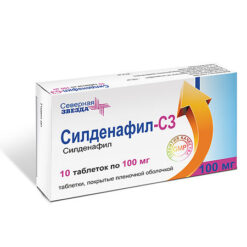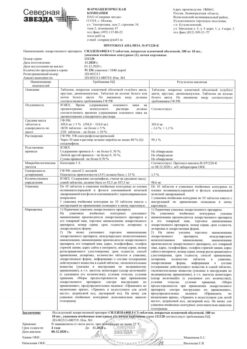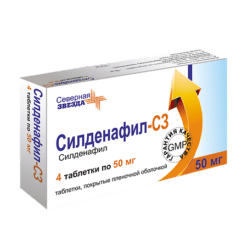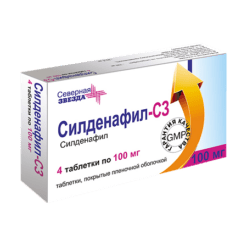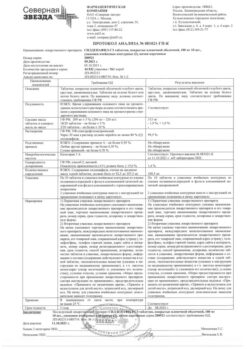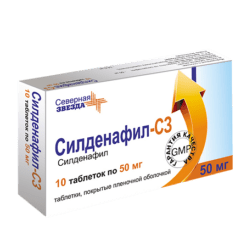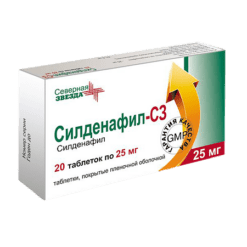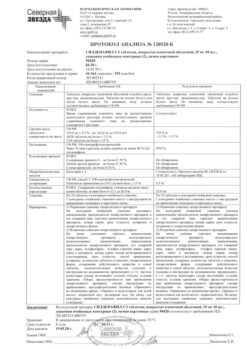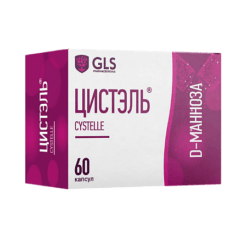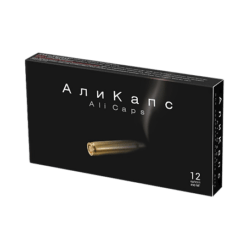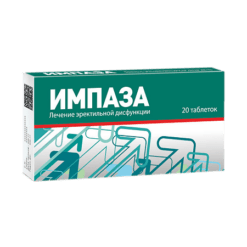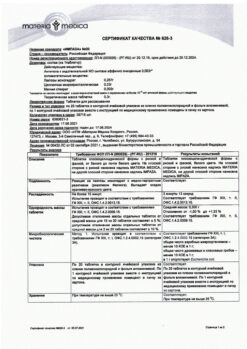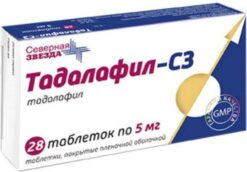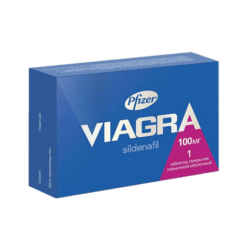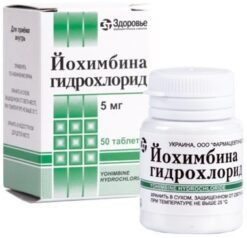No products in the cart.
Sildenafil-SZ, 100 mg 14 pcs
€11.09 €9.24
Description
Pharmacodynamics
Sildenafil is a potent selective inhibitor of cGMP-specific FDE-5.
The mechanism of action
The realization of the physiological mechanism of erection is associated with the release of nitric oxide (NO) in the cavernous body during sexual stimulation. This in turn leads to an increase in cGMP levels, a subsequent relaxation of the smooth muscle tissue of the corpora cavernosa and an increase in blood flow.
Sildenafil does not have a direct relaxing effect on the isolated human cavernous body, but it enhances the effect of nitric oxide (NO) by inhibiting FDE-5, which is responsible for the breakdown of cGMP.
Sildenafil is selective against FDE-5 in vitro, its activity against FDE-5 is superior to other known FDE isoenzymes: FDE-6 – 10 times; FDE-1 – more than 80 times; FDE-2, FDE-4, FDE-7 – FDE-11 – more than 700 times. Sildenafil is 4,000 times more selective against FDE-5 compared to FDE-3, which is of critical importance because FDE-3 is one of the key enzymes regulating myocardial contractility.
A prerequisite for the effectiveness of sildenafil is sexual stimulation.
Clinical data
Cardiology studies. Use of sildenafil in doses up to 100 mg did not result in clinically significant ECG changes in healthy volunteers. The maximum decrease in supine BP after sildenafil 100 mg was 8.3 mmHg, and the maximum decrease in BP was 5.3 mmHg. A more pronounced but also transient effect on BP was noted in patients taking nitrates.
In a study of the hemodynamic effects of sildenafil in a single dose of 100 mg in 14 patients with severe CHD (more than 70% of patients had stenosis of at least one coronary artery), resting BP and BP decreased by 7% and 6% respectively, and pulmonary BP decreased by 9%. Sildenafil did not affect cardiac output or impair blood flow in stenosed coronary arteries, and also resulted in an increase (by approximately 13%) in adenosine-induced coronary flow in both stenosed and intact coronary arteries.
In a double-blind, placebo-controlled study, 144 patients with erectile dysfunction and stable angina taking antianginal drugs (except nitrates) exercised until the severity of angina symptoms decreased. Exercise duration was significantly longer (19.9 s; 0.9-38.9 s) in patients taking sildenafil in a single dose of 100 mg compared with patients receiving placebo.
The randomized, double-blind, placebo-controlled study examined the effect of a variable dose of sildenafil (up to 100 mg) in men (n=568) with erectile dysfunction and arterial hypertension who were taking more than two antihypertensive drugs. Sildenafil improved erections in 71% of men compared with 18% in the placebo group. The incidence of adverse effects was comparable to that in other patient groups, as well as in those taking more than three antihypertensive drugs.
The studies on visual impairment. Mild and transient impairment in the ability to distinguish shades of color (blue/green) was detected in some patients 1 h after taking sildenafil at a dose of 100 mg using the Farnsworth-Mansel 100 test. These changes were absent 2 h after drug administration. It is believed that impairment of color vision is caused by inhibition of FDE-6, which is involved in the process of light transmission in the retina. Sildenafil had no effect on visual acuity, contrast perception, electroretinogram, IOP, or pupil diameter.
In a placebo-controlled, cross-over study of patients with proven early-onset macular degeneration (n=9), sildenafil at a single dose of 100 mg was well tolerated. There were no clinically significant changes in vision as assessed by specific visual tests (visual acuity, Amsler grid, color perception, color passage simulation, Hamouri perimeter, and photostress). The effectiveness and safety of sildenafil have been evaluated in 21 randomized, double-blind, placebo-controlled trials lasting up to 6 months in 3000 patients aged 19 to 87 years, with erectile dysfunction of various etiologies (organic, psychogenic or mixed). Efficacy of the drug was evaluated globally using an erection diary, the International Erectile Function Index (a validated sexual function questionnaire), and a partner survey.
The efficacy of sildenafil, defined as the ability to achieve and maintain an erection sufficient for satisfactory intercourse, has been demonstrated in all studies conducted and confirmed in long-term studies lasting 1 year. In fixed-dose studies, the proportion of patients who reported that therapy improved their erections was 62% (sildenafil dose – 25 mg), 74% (sildenafil dose – 50 mg) and 82% (sildenafil dose – 100 mg) versus 25% in the placebo group). Analysis of the International Index of Erectile Function showed that in addition to improved erections, sildenafil treatment also improved the quality of orgasm, allowed to achieve satisfaction of sexual intercourse and overall satisfaction.
The data summarized showed that among the patients who reported improved erections with sildenafil treatment, 59% had diabetes, 43% had radical prostatectomy, and 83% had spinal cord injury (versus 16%, 15%, and 12% in the placebo group, respectively).
Pharmacokinetics
The pharmacokinetics of sildenafil in the recommended dose range are linear.
Absorption
After oral administration, sildenafil is rapidly absorbed. Absolute bioavailability averages about 40% (25 to 63%). In vitro sildenafil at a concentration of about 1.7 ng/ml (3.5 nM) inhibits human FDE-5 activity by 50%. After a single sildenafil dose of 100 mg, the average Cmax of free sildenafil in plasma of men is about 18 ng/ml (38 nM) and is reached when sildenafil is taken orally on an empty stomach within an average of 60 minutes (30 to 120 minutes). When taken in combination with fatty food the absorption rate is reduced: Cmax is reduced by 29% on average, and Tmax is increased by 60 min, but the degree of absorption is not significantly changed (AUC is reduced by 11%).
Distribution
The Vss of sildenafil averages 105 L. The binding of sildenafil and its main circulating N-demethyl metabolite to plasma proteins is about 96% and is independent of the total drug concentration. Less than 0.0002% of the sildenafil dose (188 ng on average) is detected in semen 90 min after taking the drug.
Metabolism
Sildenafil is metabolized primarily in the liver by the cytochrome CYPCA4 isoenzyme (major pathway) and cytochrome CYP2C9 isoenzyme (minor pathway). The main circulating active metabolite formed as a result of N-demethylation of sildenafil undergoes further metabolism. The selectivity of this metabolite against FDE is comparable with that of sildenafil, and its activity against FDE-5 in vitro is about 50% of sildenafil activity.
The plasma concentration of this metabolite in healthy volunteers was about 40% of that of sildenafil. The N-demethyl metabolite undergoes further metabolism; T1/2 is about 4 h.
The total clearance of sildenafil is 41 l/h, and the final T1/2 is 3-5 h. After oral administration, as well as after IUI, sildenafil is excreted as metabolites, mainly by the intestine (about 80% of the oral dose) and, to a lesser extent, by the kidneys (about 13% of the oral dose).
Pharmacokinetics in special patient groups
Elderly patients. Healthy elderly patients (older than 65 years) have decreased sildenafil clearance and plasma free sildenafil concentrations are about 40% higher than those of younger patients (18-45 years). Age has no clinically significant effect on the incidence of side effects.
Kidney function abnormalities. In mild (creatinine Cl 50-80 ml/min) and moderate (creatinine Cl 30-49 ml/min) degree of renal failure, sildenafil pharmacokinetics does not change after a single oral dose of 50 mg. In severe renal failure (creatinine Cl≤30 mL/min), sildenafil clearance is decreased, resulting in approximately two-fold increase of AUC (100%) and Cmax (88%) compared to normal renal function in patients of the same age group.
Hepatic disorders. Sildenafil clearance is decreased in patients with cirrhosis (Child-Pugh stages A and B), resulting in higher AUC (84%) and Cmax (47%) than in normal hepatic function in patients in the same age group. Pharmacokinetics of sildenafil in patients with severe hepatic impairment (Child-Pugh stage C) have not been studied.
Indications
Indications
– treatment of erectile dysfunction, characterized by the inability to achieve or maintain a penile erection sufficient for satisfactory sexual intercourse.
Sildenafil is effective only during sexual stimulation.
Pharmacological effect
Pharmacological effect
Pharmacodynamics
Sildenafil is a powerful selective inhibitor of cGMP-specific PDE-5.
Mechanism of action
The physiological mechanism of erection is associated with the release of nitric oxide (NO) in the corpus cavernosum during sexual stimulation. This, in turn, leads to an increase in cGMP levels, subsequent relaxation of the smooth muscle tissue of the corpus cavernosum and increased blood flow.
Sildenafil does not have a direct relaxant effect on the isolated human corpus cavernosum, but enhances the effect of nitric oxide (NO) by inhibiting PDE5, which is responsible for the breakdown of cGMP.
Sildenafil is selective against PDE-5 in vitro, its activity against PDE-5 exceeds that against other known PDE isoenzymes: PDE-6 – 10 times; PDE-1 – more than 80 times; PDE-2, PDE-4, PDE-7 – PDE-11 – more than 700 times. Sildenafil is 4000 times more selective for PDE-5 compared to PDE-3, which is of utmost importance since PDE-3 is one of the key enzymes in the regulation of myocardial contractility.
A prerequisite for the effectiveness of sildenafil is sexual stimulation.
Clinical data
Cardiac research. The use of sildenafil in doses up to 100 mg did not lead to clinically significant ECG changes in healthy volunteers. The maximum reduction in SBP in the supine position after taking sildenafil at a dose of 100 mg was 8.3 mmHg, and DBP was 5.3 mmHg. A more pronounced, but also transient effect on blood pressure was observed in patients taking nitrates.
In a study of the hemodynamic effect of sildenafil at a single dose of 100 mg in 14 patients with severe coronary artery disease (more than 70% of patients had stenosis of at least one coronary artery), resting SBP and DBP decreased by 7 and 6%, respectively, and pulmonary SBP decreased by 9%. Sildenafil did not affect cardiac output or impair blood flow in stenotic coronary arteries, and also led to an increase (by approximately 13%) in adenosine-induced coronary flow in both stenotic and intact coronary arteries.
In a double-blind, placebo-controlled study, 144 patients with erectile dysfunction and stable angina taking antianginal drugs (except nitrates) exercised until their angina symptoms improved. The duration of the exercise was significantly longer (19.9 s; 0.9–38.9 s) in patients taking sildenafil in a single dose of 100 mg compared to patients receiving placebo.
A randomized, double-blind, placebo-controlled study examined the effect of varying the dose of sildenafil (up to 100 mg) in men (n=568) with erectile dysfunction and hypertension taking more than two antihypertensive medications. Sildenafil improved erections in 71% of men compared to 18% in the placebo group. The incidence of adverse effects was comparable to that in other patient groups, as well as in individuals taking more than three antihypertensive drugs.
Studies of visual impairments. In some patients, 1 hour after taking sildenafil at a dose of 100 mg, the Farnsworth-Mansel 100 test revealed a mild and transient impairment in the ability to distinguish shades of color (blue/green). 2 hours after taking the drug, these changes were absent. Color vision impairment is thought to be caused by inhibition of PDE6, which is involved in light transmission in the retina. Sildenafil had no effect on visual acuity, contrast perception, electroretinogram, IOP, or pupil diameter.
In a placebo-controlled crossover study of patients with proven early-onset macular degeneration (n=9), sildenafil in a single dose of 100 mg was well tolerated. There were no clinically significant changes in vision assessed by specific visual tests (visual acuity, Amsler grating, color perception, color transmission simulation, Hamuri perimeter and photostress).
Efficiency
The effectiveness and safety of sildenafil was assessed in 21 randomized, double-blind, placebo-controlled studies lasting up to 6 months in 3,000 patients aged 19 to 87 years with erectile dysfunction of various etiologies (organic, psychogenic or mixed). The effectiveness of the drug was assessed globally using an erection diary, the International Index of Erectile Function (a validated questionnaire about the state of sexual function) and a partner interview.
The effectiveness of sildenafil, defined as the ability to achieve and maintain an erection sufficient for satisfactory sexual intercourse, has been demonstrated in all studies conducted and confirmed in long-term studies lasting 1 year. In fixed-dose studies, the proportion of patients who reported that therapy improved their erections was 62% (25 mg sildenafil dose), 74% (50 mg sildenafil dose), and 82% (100 mg sildenafil dose) versus 25% in the placebo group). Analysis of the International Index of Erectile Function showed that in addition to improving erection, treatment with sildenafil also increased the quality of orgasm, achieved satisfaction from sexual intercourse and overall satisfaction.
According to the pooled data, among patients who reported improved erections with sildenafil treatment were 59% of patients with diabetes, 43% of patients who had undergone radical prostatectomy, and 83% of patients with spinal cord injuries (versus 16, 15, and 12% in the placebo group, respectively).
Pharmacokinetics
The pharmacokinetics of sildenafil in the recommended dose range is linear.
Suction
After oral administration, sildenafil is rapidly absorbed. Absolute bioavailability averages about 40% (from 25 to 63%). In vitro, sildenafil at a concentration of about 1.7 ng/ml (3.5 nM) inhibits human PDE-5 activity by 50%. After a single dose of sildenafil in a dose of 100 mg, the average Cmax of free sildenafil in the blood plasma of men is about 18 ng/ml (38 nM) and is achieved when sildenafil is taken orally on an empty stomach for an average of 60 minutes (from 30 to 120 minutes). When taken in combination with fatty foods, the rate of absorption decreases: Cmax decreases by an average of 29%, and Tmax increases by 60 minutes, but the degree of absorption does not change significantly (AUC decreases by 11%).
Distribution
Vss of sildenafil averages 105 l. The binding of sildenafil and its main circulating N-demethyl metabolite to plasma proteins is about 96% and does not depend on the total concentration of the drug. Less than 0.0002% of the sildenafil dose (average 188 ng) was found in semen 90 minutes after taking the drug.
Metabolism
Sildenafil is metabolized mainly in the liver under the influence of the cytochrome CYP3A4 isoenzyme (major pathway) and the cytochrome CYP2C9 isoenzyme (minor pathway). The main circulating active metabolite, resulting from N-demethylation of sildenafil, undergoes further metabolism. The selectivity of this metabolite for PDE is comparable to that of sildenafil, and its activity against PDE-5 in vitro is about 50% of the activity of sildenafil.
The concentration of the metabolite in the blood plasma of healthy volunteers was about 40% of the concentration of sildenafil. The N-demethyl metabolite undergoes further metabolism; T1/2 is about 4 hours.
Removal
The total clearance of sildenafil is 41 l/h, and the final half-life is 3-5 hours. After oral administration, as well as after intravenous administration, sildenafil is excreted in the form of metabolites, mainly by the intestines (about 80% of the oral dose) and to a lesser extent by the kidneys (about 13% of the oral dose).
Pharmacokinetics in special groups of patients
Elderly patients. In healthy elderly patients (over 65 years of age), the clearance of sildenafil is reduced, and the concentration of free sildenafil in the blood plasma is approximately 40% higher than in young patients (18–45 years of age). Age does not have a clinically significant effect on the incidence of side effects.
Renal dysfunction. With mild (Cl creatinine – 50-80 ml/min) and moderate (Cl creatinine – 30-49 ml/min) degree of renal failure, the pharmacokinetics of sildenafil after a single oral dose of 50 mg does not change. In severe renal failure (Cl creatinine ≤30 ml/min), the clearance of sildenafil is reduced, which leads to an approximately twofold increase in AUC (100%) and Cmax (88%) compared to those with normal renal function in patients of the same age group.
Liver dysfunction. In patients with liver cirrhosis (Child-Pugh stages A and B), the clearance of sildenafil is reduced, resulting in an increase in AUC (84%) and Cmax (47%) compared to those with normal liver function in patients of the same age group. The pharmacokinetics of sildenafil in patients with severe liver dysfunction (Child-Pugh stage C) has not been studied.
Special instructions
Special instructions
To diagnose erectile dysfunction, determine its possible causes and select adequate treatment, it is necessary to obtain a complete medical history and conduct a thorough physical examination. Treatments for erectile dysfunction should be used with caution in patients with anatomical deformation of the penis (angulation, cavernous fibrosis, Peyronie’s disease), or in patients with risk factors for the development of priapism (sickle cell anemia, multiple myeloma, leukemia).
Medicines intended to treat erectile dysfunction should not be prescribed to men for whom sexual activity is undesirable.
Sexual activity poses a certain risk in the presence of heart disease, so before starting any therapy for erectile dysfunction, the doctor should refer the patient for an examination of the condition of the cardiovascular system. Sexual activity is undesirable in patients with heart failure, unstable angina, myocardial infarction or stroke in the last 6 months, life-threatening arrhythmias, arterial hypertension (BP > 170/100 mm Hg) or hypotension (BP < 90/50 mm Hg). Clinical studies showed no difference in the incidence of myocardial infarction (1.1 per 100 people per year) or the incidence of death from cardiovascular diseases (0.3 per 100 people per year) in patients receiving Sildenafil-SZ compared with patients receiving placebo.
Cardiovascular complications
During post-marketing use of sildenafil for the treatment of erectile dysfunction, adverse events such as serious cardiovascular events (including myocardial infarction, unstable angina, sudden cardiac death, ventricular arrhythmia, hemorrhagic stroke, transient ischemic attack, hypertension and hypotension) were reported, which were temporarily associated with the use of sildenafil. Most of these patients, but not all of them, had risk factors for cardiovascular complications. Many of these adverse events occurred shortly after sexual activity, and some of them occurred after taking sildenafil without subsequent sexual activity. It is not possible to establish a direct connection between the observed adverse events and these or other factors.
Hypotension
Sildenafil has a systemic vasodilating effect, leading to a transient decrease in blood pressure, which is not a clinically significant phenomenon and does not lead to any consequences in most patients. However, before prescribing Sildenafil-SZ, the physician should carefully assess the risk of possible undesirable manifestations of the vasodilating effect in patients with relevant diseases, especially against the background of sexual activity. Increased susceptibility to vasodilators is observed in patients with obstruction of the left ventricular outflow tract (aortic stenosis, hypertrophic obstructive cardiomyopathy), as well as with the rare syndrome of multiple system atrophy, manifested by severe dysregulation of blood pressure from the autonomic nervous system.
Since the combined use of sildenafil and alpha-blockers may lead to symptomatic hypotension in some sensitive patients, Sildenafil-SZ should be administered with caution to patients taking alpha-blockers. To minimize the risk of developing postural hypotension in patients taking alpha-blockers, Sildenafil-SZ should be started only after hemodynamic stability has been achieved in these patients. The advisability of reducing the initial dose of Sildenafil-SZ should also be considered. The physician should inform patients about what actions to take if symptoms of postural hypotension occur.
Visual impairment
Rare cases of anterior non-arteritic ischemic optic neuropathy have been reported as a cause of deterioration or loss of vision with the use of all PDE5 inhibitors, including sildenafil. Most of these patients had risk factors such as optic disc excavation, age over 50 years, diabetes mellitus, hypertension, coronary artery disease, hyperlipidemia, and smoking. A cause-and-effect relationship between the use of PDE5 inhibitors and the development of anterior non-arteritic ischemic optic neuropathy has not been identified. The physician should inform the patient about the increased risk of developing anterior non-arteritic ischemic optic neuropathy if this condition has already been noted. In case of sudden loss of vision, patients should receive the necessary medical attention immediately. A small number of patients with hereditary retinitis pigmentosa have genetically determined dysfunction of retinal phosphodiesterases. There is no information on the safety of using Sildenafil-SZ in patients with retinitis pigmentosa, so sildenafil should be used with caution.
Hearing impairment
Some post-marketing and clinical studies have reported cases of sudden deterioration or loss of hearing associated with the use of all PDE5 inhibitors, including sildenafil. Most of these patients had risk factors for sudden deterioration or loss of hearing. A cause-and-effect relationship between the use of PDE5 inhibitors and sudden hearing loss or deterioration has not been established. If there is a sudden deterioration in hearing or hearing loss while taking sildenafil, you should consult your doctor immediately.
Bleeding
Sildenafil enhances the antiplatelet effect of sodium nitroprusside, a nitric oxide donor, on human platelets in vitro. There are no data on the safety of sildenafil in patients with a tendency to bleeding or exacerbation of gastric and duodenal ulcers, so Sildenafil-SZ should be used with caution in these patients. The incidence of epistaxis in patients with PH associated with diffuse connective tissue diseases was higher (sildenafil 12.9%, placebo 0%) than in patients with primary pulmonary hypertension (sildenafil 3%, placebo 2.4%). In patients receiving sildenafil in combination with a vitamin K antagonist, the incidence of epistaxis was higher (8.8%) than in patients not taking a vitamin K antagonist (1.7%).
Use in conjunction with other means of treating erectile dysfunction.
The safety and effectiveness of using Sildenafil-SZ in combination with other drugs for the treatment of erectile dysfunction have not been studied, so the use of such combinations is not recommended.
Impact on the ability to drive vehicles and operate machinery
While taking sildenafil, no negative effects on the ability to drive a car or use other technical equipment were observed.
However, since when taking sildenafil, a decrease in blood pressure, the development of chromatopsia, blurred vision and other side effects is possible, you should be careful about the individual effect of the drug in these situations, especially at the beginning of treatment and when changing the dosage regimen.
Active ingredient
Active ingredient
Sildenafil
Composition
Composition
1 tablet sildenafil (in citrate form) 100 mg
Excipients:
microcrystalline cellulose – 83.5 mg,
lactose monohydrate (milk sugar) – 83.5 mg,
croscarmellose sodium (primellose) – 15 mg,
povidone (medium molecular weight polyvinylpyrrolidone) – 15 mg,
magnesium stearate – 3 mg.
Shell composition:
Opadry II (polyvinyl alcohol, partially hydrolyzed – 3.6 mg, titanium dioxide (E171) – 2.061 mg, macrogol (polyethylene glycol 3350) – 1.818 mg, talc – 1.332 mg, aluminum varnish based on brilliant blue – 0.1728 mg, iron oxide (II) yellow (E172) – 0.0153 mg, iron oxide (II) black (E172) – 0.0009 mg).
Contraindications
Contraindications
– use in patients receiving continuous or intermittent nitric oxide donors, organic nitrates or nitrites in any form, since sildenafil enhances the hypotensive effect of nitrates;
— according to its registered indication, the drug Sildenafil-SZ is not intended for use in children and adolescents under the age of 18 years;
— according to its registered indication, the drug Sildenafil-SZ is not intended for use in women;
– lactase deficiency, lactose intolerance, glucose-galactose malabsorption;
– simultaneous use of sildenafil with ritonavir is not recommended;
– hypersensitivity to sildenafil or to any other component of the drug.
The safety and effectiveness of Sildenafil-SZ when used in combination with other drugs for the treatment of erectile dysfunction have not been studied, therefore the use of such combinations is not recommended.
With caution:
– anatomical deformation of the penis (angulation, cavernous fibrosis or Peyronie’s disease);
– diseases predisposing to the development of priapism (sickle cell anemia, multiple myeloma, leukemia, thrombocythemia);
– diseases accompanied by bleeding;
– exacerbation of peptic ulcer of the stomach and duodenum;
– hereditary retinitis pigmentosa;
– heart failure, unstable angina, myocardial infarction, stroke or life-threatening arrhythmias in the last 6 months, arterial hypertension (BP >170/100 mm Hg) or hypotension (BP < 90/50 mm Hg);
– in patients with episodes of anterior non-arteritic ischemic optic neuropathy (history).
Interaction
Interaction
The influence of other drugs on the pharmacokinetics of sildenafil
The metabolism of sildenafil occurs mainly under the influence of the cytochrome isoenzymes CYP3A4 (the main pathway) and CYP2C9, therefore inhibitors of these isoenzymes can reduce the clearance of sildenafil, and inducers, accordingly, increase the clearance of sildenafil. A decrease in the clearance of sildenafil was noted with simultaneous use of inhibitors of the cytochrome CYP3A4 isoenzyme (ketoconazole, erythromycin, cimetidine). Cimetidine (800 mg), a nonspecific inhibitor of the cytochrome CYP3A4 isoenzyme, when taken together with sildenafil (50 mg), causes an increase in plasma sildenafil concentrations by 56%. A single dose of sildenafil in a dose of 100 mg together with erythromycin (500 mg 2 times a day for 5 days), a specific inhibitor of the cytochrome CYP3A4 isoenzyme, while achieving a constant concentration of erythromycin in the blood, leads to an increase in the AUC of sildenafil by 182%.
When co-administered with sildenafil (100 mg once) and saquinavir (1200 mg/day 3 times/day), an inhibitor of HIV protease and the cytochrome CYP3A4 isoenzyme, while achieving a constant concentration of saquinavir in the blood, the Cmax of sildenafil increased by 140%, and the AUC increased by 210%. Sildenafil has no effect on the pharmacokinetics of saquinavir.
Stronger inhibitors of the cytochrome CYP3A4 isoenzyme, such as ketoconazole and itraconazole, may cause more severe changes in the pharmacokinetics of sildenafil.
The simultaneous use of sildenafil (100 mg once) and ritonavir (500 mg 2 times a day), an HIV protease inhibitor and a strong cytochrome P450 inhibitor, while achieving a constant concentration of ritonavir in the blood leads to an increase in sildenafil Cmax by 300% (4 times), and AUC by 1000% (11 times). After 24 hours, the concentration of sildenafil in the blood plasma is about 200 ng/ml (after a single dose of sildenafil alone – 5 ng/ml), which is consistent with information about the pronounced effect of ritonavir on the pharmacokinetics of various cytochrome P450 substrates. Sildenafil has no effect on the pharmacokinetics of ritonavir. The combined use of sildenafil with ritonavir is not recommended.
If sildenafil is taken in recommended doses by patients simultaneously receiving strong inhibitors of the cytochrome CYP3A4 isoenzyme, then the Cmax of free sildenafil does not exceed 200 nM, and the drug is well tolerated.
A single dose of an antacid (magnesium hydroxide/aluminum hydroxide) does not affect the bioavailability of sildenafil.
Inhibitors of the cytochrome CYP2C9 isoenzyme (tolbutamide, warfarin), the cytochrome CYP2D6 isoenzyme (selective serotonin reuptake inhibitors, tricyclic antidepressants), thiazide and thiazide-like diuretics, ACE inhibitors and calcium antagonists do not affect the pharmacokinetics of sildenafil.
Azithromycin (500 mg/day for 3 days) has no effect on the AUC, Cmax, Tmax, elimination rate constant and T1/2 of sildenafil or its main circulating metabolite.
Effect of sildenafil on other drugs
Sildenafil is a weak inhibitor of cytochrome P450 isoenzymes -1A2, 2C9, 2C19, 2D6, 2E1 and 3A4 (IC50>150 µmol). When sildenafil is taken at recommended doses, its Cmax is approximately 1 µmol, so it is unlikely that sildenafil could affect the clearance of substrates of these isoenzymes.
Sildenafil enhances the hypotensive effect of nitrates both with long-term use of the latter and when they are prescribed for acute indications. In this regard, the use of sildenafil in combination with nitrates or nitric oxide donors is contraindicated.
When co-administering the alpha-blocker doxazosin (4 mg and 8 mg) and sildenafil (25 mg, 50 mg and 100 mg) in patients with benign prostatic hyperplasia with stable hemodynamics, the average additional decrease in systolic/diastolic blood pressure in the supine position was 7/7 mm Hg. art., 9/5 mm Hg. and 8/4 mm Hg, respectively, and in a standing position – 6/6 mm Hg, 11/4 mm Hg. and 4/5 mmHg, respectively. Rare cases of symptomatic postural hypotension, manifested in the form of dizziness (without fainting), have been reported in such patients. In selected sensitive patients receiving alpha-blockers, concomitant use of sildenafil may lead to symptomatic hypotension.
There were no signs of significant interaction with tolbutamide (250 mg) or warfarin (40 mg), which are metabolized by the cytochrome CYP2C9 isoenzyme.
Sildenafil (100 mg) does not affect the pharmacokinetics of HIV protease inhibitors, saquinavir and ritonavir, which are substrates of the cytochrome CYP3A4 isoenzyme, at their constant blood levels.
Sildenafil (50 mg) does not cause an additional increase in bleeding time when taking acetylsalicylic acid (150 mg).
Sildenafil (50 mg) does not enhance the hypotensive effect of ethanol in healthy volunteers with a maximum ethanol concentration in the blood of an average of 0.08% (80 mg/dL).
In patients with arterial hypertension, no signs of interaction between sildenafil (100 mg) and amlodipine were detected. The average additional decrease in blood pressure in the supine position is 8 mm Hg. (systolic) and 7 mm Hg. (diastolic).
The use of sildenafil in combination with antihypertensive drugs does not lead to additional side effects.
Overdose
Overdose
Symptoms: with a single dose of Sildenafil-SZ in a dose of up to 800 mg, adverse events were comparable to those when taking the drug in lower doses, but were more common.
Treatment: symptomatic therapy. Hemodialysis does not accelerate the clearance of sildenafil, because the latter actively binds to plasma proteins and is not excreted by the kidneys.
Storage conditions
Storage conditions
In a dry place, protected from light, at a temperature not exceeding 25 ° C. Keep out of the reach of children.
Shelf life
Shelf life
3 years. Do not use after the expiration date stated on the package.
Manufacturer
Manufacturer
North Star NAO, Russia
Additional information
| Shelf life | 3 years. Do not use after the expiration date printed on the package. |
|---|---|
| Conditions of storage | Store in a dry place protected from light at a temperature not exceeding 25 °С. Keep out of reach of children. |
| Manufacturer | North Star NAO, Russia |
| Medication form | pills |
| Brand | North Star NAO |
Other forms…
Related products
Buy Sildenafil-SZ, 100 mg 14 pcs with delivery to USA, UK, Europe and over 120 other countries.


